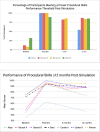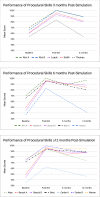Retention of Critical Procedural Skills After Simulation Training: A Systematic Review
- PMID: 34099989
- PMCID: PMC8166305
- DOI: 10.1002/aet2.10536
Retention of Critical Procedural Skills After Simulation Training: A Systematic Review
Abstract
Objective: While short-term gains in performance of critical emergency procedures are demonstrated after simulation, long-term retention is relatively uncertain. Our objective was to determine whether simulation of critical emergency procedures promotes long-term retention of skills in nonsurgical physicians.
Methods: We searched multiple electronic databases using a peer-reviewed strategy. Eligible studies 1) were observational cohorts, quasi-experimental or randomized controlled trials; 2) assessed intubation, cricothyrotomy, pericardiocentesis, tube thoracostomy, or central line placement performance by nonsurgical physicians; 3) utilized any form of simulation; and 4) assessed skill performance immediately after and at ≥ 3 months after simulation. The primary outcome was skill performance at or above a preset performance benchmark at ≥ 3 months after simulation. Secondary outcomes included procedural skill performance at 3, 6, and ≥ 12 months after simulation.
Results: We identified 1,712 citations, with 10 being eligible for inclusion. Methodologic quality was moderate with undefined primary outcomes; inadequate sample sizes; and use of nonstandardized, unvalidated tools. Three studies assessed performance to a specific performance benchmark. Two demonstrated maintenance of the minimum performance benchmark while two demonstrated significant skill decay. A significant decline in the mean performance scores from immediately after simulation to 3, 6, and ≥ 12 months after simulation was observed in four of four, three of four, and two of five studies, respectively. Scores remained significantly above baseline at 3, 6, and ≥ 12 months after simulation in three of four, three of four, and four of four studies, respectively.
Conclusion: There were a limited number of studies examining the retention of critical skills after simulation training. While there was some evidence of skill retention after simulation, overall most studies demonstrated skill decline over time.
© 2020 by the Society for Academic Emergency Medicine.
Figures



References
-
- Waymack JR, Markwell S, Milbrandt JC, Clark TR. Comparison of rates of emergency department procedures and critical diagnoses in metropolitan and rural hospitals. Rural Remote Health 2015;15:3298. - PubMed
-
- Ahya SN, Barsuk JH, Cohen ER, Tuazon J, McGaghie WC, Wayne DB. Clinical performance and skill retention after simulation‐based education for nephrology fellows. Semin Dial 2012;25:470–3. - PubMed
-
- Mittiga MR, Geis GL, Kerrey BT, Rinderknecht AS. The spectrum and frequency of critical procedures performed in a pediatric emergency department: implications of a provider‐level view. Ann Emerg Med 2013;61:263–70. - PubMed
-
- Schoenfeld PS, Baker MD. Management of cardiopulmonary and trauma resuscitation in the pediatric emergency department. Pediatrics 1993;91:726–29. - PubMed
-
- Bradley P. The history of simulation in medical education and possible future directions. Med Educ 2006;40:254–62. - PubMed
LinkOut - more resources
Full Text Sources

